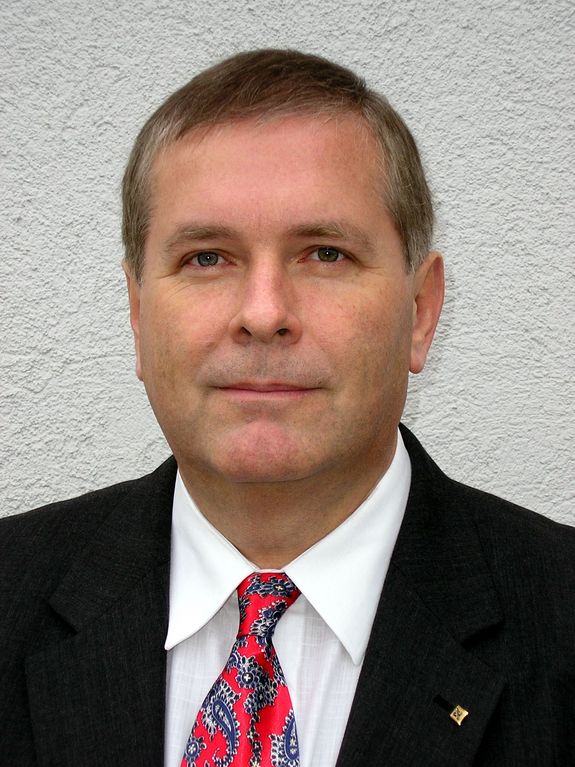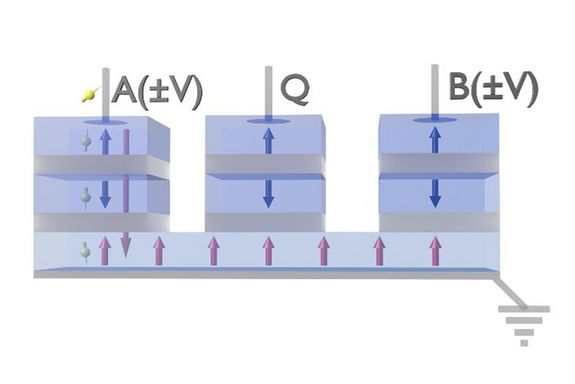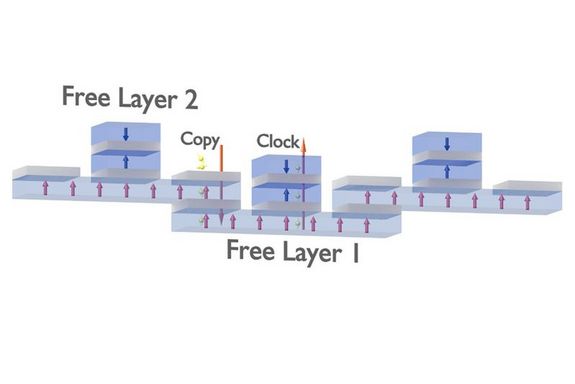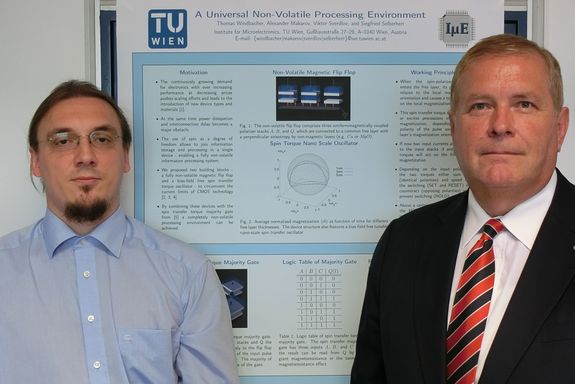Microelectronics have long been continuously improving by the miniaturisation of components. But those days are over: science is now hitting physical barriers. Further progress requires alternative ideas and spintronics is particularly promising. Not only does it use the electrical charge of electrons, it also makes use of their intrinsic angular momentum, or spin. Electrical engineers Professor Siegfried Selberherr and Thomas Windbacher at the Institute for Microelectronics at TU Wien have succeeded in developing a flip-flop based purely on spintronics - an essential component in electronics. Now, with a prestigious ERC Proof of Concept Grant, the first prototypes can be built to make the already-patented idea commercially viable. The project was selected for funding by the European Research Council last year. Now all the requirements have been fulfilled, the project can begin.
First calculate, then construct
Siegfried Selberherr's team has been conducting successful research in the field of spintronics for a number of years - evidenced by numerous patents and an ERC Advanced Grant awarded to Selberherr in 2010. Spintronics components are developed on a computer, rather than in a laboratory: "Huge, elaborate computer simulations are required to calculate, understand and improve the behaviour of components," explains Selberherr. On the basis of the fundamental laws of quantum physics, we are investigating the behaviour of components, thus enabling us to optimise them before they are even produced."
One problem in electronics these days is the need for energy and time. Transporting the electrical charges to the places where they are required constantly requires energy to be expended, so that the charge remains there. Starting up a mobile phone, when all charges remain where they were before it was switched off, takes time. "Spintronics would solve this problem," says Thomas Windbacher. "Spintronics is superior when it comes to energy consumption and speed. The problem however is that it does not currently achieve the extreme integration density of conventional electronics."
Spintronics will ultimately be more compact
Microelectronics can be built to extremely compact dimensions these days. In spintronics, only hybrid solutions are currently used - combined with conventional microelectronics. As a result, additional signal converters are required that mediate between the charge-based electronics and the spin-based spintronics. This makes additional components necessary and thus increases the space required. Selberherr's team at TU Wien has now developed components that function solely in the spintronics arena and no longer require any signal conversion between these two worlds.
This has given rise to a purely spintronic flip-flop - a fundamentally important component. Flip-flops can be switched back and forth between two different states; they are elementary one-bit memories. Our flip-flop utilises the spin-transfer-torque effect and the magnetic exchange interaction for the operation, thus enabling an extremely compact structure," explains Siegfried Selberherr. The new flip-flop requires less than one tenth of the footprint of currently known flip-flops. It can also be stacked onto a shift register - an important logical switching device, that can thus be accommodated in extremely small areas.
ERC Proof of Concept Grant Facts
With the Proof of Concept grants, the ERC has created an opportunity for specifically funding the commercial use of ideas and research findings arising within the scope of ERC grants. The aim of a PoC grant is often to prepare a presentation package, to persuade venture capitalists, businesses and/or social entrepreneurs to invest in this technology and guide it through the early marketing phase.
Infobox: Details about the flip-flop
The flip-flop consists of three magnetically hard antiferromagnetically coupled stacks. Two of the stacks (A and B - see graphic) serve to polarise the incoming signals, whilst stack Q is used for reading. All three stacks are connected by means of non-magnetic layers to a joint magnetic-free layer.
Depending on whether positive or negative voltage is created at the inputs, currents with different spin polarisations are created. These currents flow into the joint magnetic-free layer, where they exert torques on the local magnetisation. These torques can either try to tip the magnetic orientation of this joint layer (where there is equal polarity for both input signals) or dampen it (opposite polarity). This behaviour corresponds exactly with the operations required for a flip-flop: SET, RESET and HOLD.
Connection of the new flip-flops to a shift register is extremely compact. This is done by arranging them into rows, such that the edges of one flip-flop overlap with the edges of its neighbouring flip-flop (see graphic). The fundamental properties and principal viability of the flip-flop and shift register have already been investigated by means of extensive micro-magnetic simulations.
Contact
Prof. Siegfried Selberherr
Institute of Microelectronics
TU Wien
Gußhausstraße 25-29, 1040 Vienna
Phone: +43 1 58801 36010
Email: siegfried.selberherr@tuwien.ac.at
Dr. Thomas Windbacher
Institute of Microelectronics
TU Wien
Gußhausstraße 25-29, 1040 Vienna
Phone: +43 1 58801 36018
Email: thomas.windbacher@tuwien.ac.at
Sender
Dr. Florian Aigner
Service Unit of PR and Marketing
TU Wien
Operngasse 11, 1040 Vienna
Phone: +43 1 58801 41027
Email: florian.aigner@tuwien.ac.at



